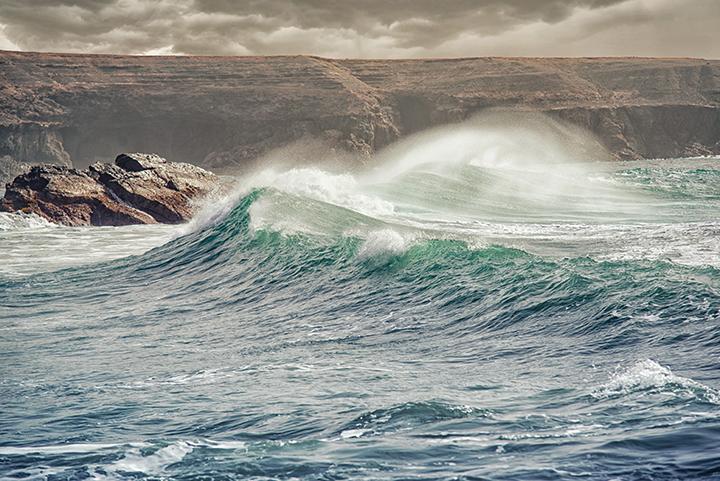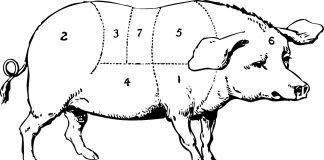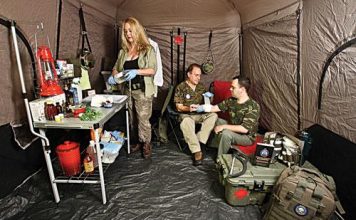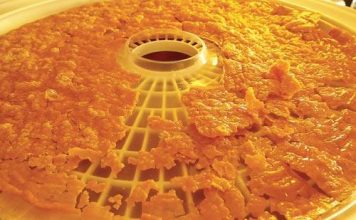 |
|
| Issue #94 • July/August, 2004 |
I was sitting in my cubicle poring over a map of the Oregon coastactually, just that part of the coast that is Gold Beach where Backwoods Home Magazine is located. Suddenly, I heard a voice behind me ask, “What map is that, John?”
I just about jumped out of my skin. I turned around and there, standing over me, was O.E. MacDougal, our poker playing friend from southern California. He was holding a grocery bag in his left arm.
“Sorry, I didn’t mean to startle you,” he said.
“It’s okay,” I said, “I’m just jumpy.”
He nodded “I forgot.”
“Tsunami Hazard Map of the Gold Beach Area, Curry County, Oregon,” he read from the top of the map. “Are you expecting a tsunami?”
“Well, sort of. I mean, I’ve been told one will happen sooner or later.”
“It will!” he said.
I looked at him. That kind of certainty from Mac was unsettling. “You really think so?”
“Well, this area is one big subduction zone, and you know the old saying, ‘It’s not a matter of if, but when.’
“Really!” I said.
“One of the things that’s certain from the geological record,” Mac went on, “is that there have been plenty of tsunamis, or tidal waves, on this coast before and you can bet that there’ll be more. And the odds are pretty good that it will be a big one, possibly much bigger than the one that hit Asia the day after Christmas six months ago. That was caused by an earthquake on a similar subduction zone. The Asia tidal waves killed 250,000 people.”
“You’re using both terms, Mac. Is there a difference between a tsunami and a tidal wave?” Dave asked. Dave Duffy, the publisher of BHM, had just walked in.
“Hi, Dave. Good to see you,” Mac said shaking Dave’s hand.
“No difference,” he continued. “They’re also called seismic sea waves, and sometimes they’re called names I’d never say in front of small children or my mother. But that’s only when they’re barreling down on you.”
“How do you like the new office?” Dave asked.
“I like it.”
“Want a tour?”
“Sure.”
“What’s in the grocery bag?” Dave asked.
“I told Ilene I’d make lunch. You guys hungry?” Mac asked.
“Sure,” Dave and I said in unison.
“Well, I am too, and lunch is what’s in the bag, so let me fix it, then we’ll take the tour.”
|
We led Mac from my cubicle to the lunchroom.
He placed his bag on one of the counters and proceeded to go to work.
“What are you making for us this time?” Dave asked.
“Sort of a fish salad.”
“Your own recipe?”
“Yeah. I’m sure I’m not the first person to come up with this idea, but I’d never seen one before.
“So, what’s with the interest in tsunamis?” he asked.
“I want John to write something about them,” Dave said. “I watched a TV program on the Discovery Channel that stated our Pacific Northwest coastline has a very similar subduction zone to the one that spawned the tsunami waves in Asia. They said it could happen here.”
“It has and it could,” Mac said. “In fact, it will happen here.” He started to shred some lettuce.
“That’s what the program said; it’s only a matter of when. Mac, what do you know about tsunamis?”
“Well, most tsunamis are caused by earthquakes and that’s what’s most likely to cause a big one here. But earthquakes aren’t the only cause. The next leading causes are submarine landslides, then volcanoes, and least often they’re caused by impacts from celestial bodieslike the one that finished off the dinosaurs. That one probably sent a tsunami clear across the Florida peninsula.”
The Cascadia Subduction Zone
“But here the chief danger is tsunamigenic earthquakesthey’re the earthquakes that most often cause tsunamis. They occur at what are called subduction zones.”
“Just what is a subduction zone?” I asked.
“It’s where one of the tectonic plates that makes up the surface of the earth is moving under another one, as opposed to the plates sliding past each other horizontally, as they do in much of Southern California. You have the Cascadia Subduction Zone here, and it may be one of the worst in the world when it comes to its potential to spawn a tsunami.”
“How would it happen?” I asked.
“At a subduction zone, when the fault between two tectonic plates finally breaks, the plate on one side of the fault bounces up while the plate on the other side often sinks. When this occurs under the ocean it creates a huge ‘paddle effect’ that moves an enormous amount of water creating a tsunami.”
“How big could the tsunami be?” Dave asked.
“There are no hard and fast rules for the sizes tsunamis come in. An earthquake-generated tsunami is usually about 30 feet high. But it’s possible a really large earthquake, like one along a major subduction zone such as you have here along your coast, or one that’s accompanied by underwater landslides, could cause a tsunami that’s 50 to 100 feet high. That’s much bigger than the ones that hit Asia. They’re unusual, but some geologists feel that could be in the future of the Pacific Northwest coastline because of the severity of the Cascadia Subduction Zone.
An East Coast tsunami?
“However, they can be even bigger than that. There are scientists who believe a volcanic eruption in the Canary Islands, off the shore of West Africa, could lead to the collapse of the western flank of the Cumbre Vieja volcano on the island of La Palma. It would create a landslide that would drop as much as 125 cubic miles of rock into the Atlantic Ocean and create a tsunami at least 150 feet highand perhaps as much as 300 feet highthat would hit the East Coast from Florida to Maine.”
|
“What would a tsunami like that do?” I asked.
“It would wash inland for miles and cause trillions of dollars in destruction. But the good news is that it would take nine hours before it reached Boston, New York, and other places along the East Coast, allowing plenty of time for warning. The bad news is that there’s no in-place warning system or evacuation plan for the Atlantic seaboard so it’s likely there would still be a huge loss of life.”
“This sounds like science fiction,” Dave said.
“It’s not. Two of the scientists who have written about it are Dr. Steven Ward of the University of California and Dr. Simon Day of the Benfield Greig Hazard Research Center at University College London.”
“How likely is such an event?” Dave asked.
“It’s one of those things that no one knows for sure. Volcano prediction is still in its infancy. But sonar mappings of the seabed off the islands have revealed deposits from a dozen or so large collapses that occurred there in the past. So we know it can and does happen there, just like it can and did happen here.”
“Can we get back to the West Coast?” I asked.
Mac was slicing mushrooms. “Okay,” Mac said. “A subduction zone like you have here is much different than the faults you have in, say, Southern California, where the fault lines generally move parallel to each other. When the tectonic plates just slide past each other, horizontally, they usually don’t create tsunamis. But in a subduction zone, the tectonic plates move over and under each other, and when the earth under the ocean moves up or down like that suddenly, it moves an incredible amount of water that creates a tsunami. And it is also possible that the shaking from one of those kinds of earthquakes could cause an underwater landslide, and that in itself can cause a huge displacement of water that creates a tsunami.”
“Can you give me an analogy of all this tectonic plate movement stuff?” I asked.
“Imagine the surface of the earth is like a soft boiled egg whose shell is rife with cracks,” Mac said. “Some of the pieces of the shell are big while others are small. But unlike an egg, where the pieces stick to the egg, the earth’s shellthe tectonic plates floats on top of nearly molten rock deep inside the earth. That’s where we are, living on these pieces of shell that are literally floating on this nearly molten rock. Some float past each other like barges floating on a river, but others crash head-on, with one trying to go under the other.”
“And where they’re trying to go over and under each other is called a subduction zone,” Dave said.
“That’s right. Earthquakes occur because all the plates, whether they’re moving horizontally against each other or trying to move over and under each other, tend to hang up on each other along their edges. Meanwhile, the motion of the nearly molten rock beneath tries to keep them moving. The forces that are trying to move them start to accumulate. Eventually, those forces get so strong that something has to give, and the fault literally breaks, and when all that energy is released, wham! That’s your earthquake. And here along the Pacific Northwest coast, that’s the likely trigger for your tsunami.”
“How powerful can they get? Is there a limit to an earthquake’s size?” I asked.
“There appears to be. The reason you won’t see too many quakes that go much over a 9.5 on the Richter scale is because the rocks just can’t hold much more energy without breaking. The largest recorded earthquake in history was the 9.5 Chilean earthquake of 1960. It’s possible that one could be a little larger, but there’s a limit, somewhere. Maybe it’s 10, maybe it’s a little higher.”
“Exactly what is the Richter?” I asked.
He was cutting up a red bell pepper, and paused as if to search his memory. “It’s a scale of measurement invented by two guys, Charles Richter and Beno Gutenberg, for quantifying the magnitude of earthquakes.”
The Richter Scale
“But how do the numbers on the scale work?” Dave asked. “I mean, it doesn’t seem like there should be much of a difference between an earthquake that’s a 4 on the Richter scale and one that’s a 7. Yet, there is.”
“It’s a logarithmic scale,” Mac replied, “and first you’ve got to understand what a logarithmic scale is.
“Using what’s called a common logarithm, the number 10 is represented by the number 1, the number 100 by the number 2, the number 1,000 by the number 3…”
|
“It sounds like powers of 10,” Dave said. “10 to the first power is equal to 10, 10 to the second power is 100, 10 to the third power is 1000.”
“You’ve got it,” Mac said. “So, when you go from an earthquake that’s measured as a 4 on the Richter scale to one that’s a 5, the one that’s a 5 is 10 times more powerful than the one that’s a 4.”
Dave said, “So if you go from a 4 to a 7, it’s three powers of 10 making a 7…” He paused for a second and mumbled under his breath, “…10 times 10 times 10 …
“1000 times more powerful than a 4,” he said out loud.
“Right,” Mac said.
“So when you’re talking about a 9, that’s gotta be one huge earthquake,” Dave said.
“It’s a monster,” Mac replied.
“It’s 100,000 times greater than a 4,” Dave said.
“That’s right,” Mac replied.
“Another mystery cleared up,” Dave said. “But I have another question. Is there a nuclear bomb equivalent to the Richter scale? I mean, they’re always comparing volcanic explosions and hurricanes to atom bombs.”
“Sort of. The Richter scale measures the intensity of a quake. But how much energy is released depends on both the intensity and how long the quake lasts.
“Typically, a 5 on the Richter scale releases about 1½ times as much energy as the atom bomb dropped on Nagasaki. A 6 on the scale is like a one-megaton bomb or about 50 Nagasaki bombs exploding.
“Each whole number increase on the Richter scale translates into about 30 times more energy released.
“The Northridge, California, earthquake of 1994 was a 6.7.” He picked up the calculator. “Figure it released about as much energy as a five-megaton bomb, or about 500 Nagasaki bombs.”
“Wow!” was all I could say.
“What about the San Francisco earthquake of 1906?” Dave asked.
“That’s a tough one,” Mac said. “The traditional number assigned to it is 8.25, though it may have been smaller, but we’ll go with 8.25.”
He pushed a few keys on the calculator. “It released the energy of some 95,000 Nagasaki bombs going off in the ground under the city.”
“The numbers are becoming incomprehensible,” I said.
“They are,” Mac agreed.
“What about the quake in Indonesia?” Dave asked. “I understand that was about a 9.3.”
Using the calculator again, he said, “It was like more than three million of those bombs going off in one place. But keep in mind, these are just rough figures.”
“Yeah, but it gives me an appreciation for just how powerful earthquakes can be,” Dave said.
Mac was now putting a variety of seasonings on the salad.
“Here’s another thing about tsunamis. Although the dangerous ones are the ones that are caused by earthquakes at subduction zones, there are some other factors. For example, the more shallow they are, the bigger they are. The really dangerous ones are those generated by earthquakes centered 30 miles or less below the earth’s surface, in an ocean, near a subduction zone, and with a magnitude of 8.5 or greater. And they’re even worse if they also cause an underwater landslide.
“You said landslides are the second most common cause of tsunamis,” Dave said.
Mac put the salad in the refrigerator, then started seasoning a piece of red snapper as we watched. “That’s right.”
“I presume a landslide causes a tsunami just by creating an almost instantaneous displacement of water,” Dave said.
“That’s exactly how they do it.”
|
“And it’s possible they could get as big as 300 feet high, like the one that could come out of the Canary Islands?” Dave asked.
“Bigger. The highest tsunami on record was caused by a landslide in Lituya Bay in Alaska in 1958. The landslide itself was triggered by an earthquake, but the tsunami was caused by the earth that slid off a mountain and fell into the bay.”
“How big was it?” I asked.
“It depends on how you measure it. Some say it was 1720 feet high.”
“Yikes!” I said. “That’s like a third of a mile high.”
“But…the 1720 feet was actually how high it ran up on the mountain on the other side of the bay. The wall of water itself, as it crossed the bay, was anywhere from 150 to 500 feet high. No one knows for sure. We have eyewitness accounts from two of the three fishing boats that were in the bay at the time.”
“What about the third boat?” I asked.
“The crew drowned when their boat capsized.”
“The other two boats rode out the tsunami?” Dave asked.
“It was a miracle,” Mac responded.
“Why didn’t it create damage further away? Like across the ocean?” I asked.
“Even though it was high, it was only a few miles wide. When it left the bay and entered into the vastness of the open ocean, it dissipated rapidly.
“On the other hand, an earthquake-generated tsunami is going to start out at least as long as the fault that creates itthe one in Sumatra was some 750 miles long. Waves that broad don’t dissipate quickly.”
“Is there any danger to us here, on the West Coast of the United States, from landslide-generated tsunamis?” I asked.
He put some olive oil and sesame oil in a skillet he had heating, then added the fish. “There can be. Earthquakes can cause landslides along any of the continental shelves that lie off our coasts. The earthquake wouldn’t even have to be that severe. All it would have to do is trigger a large underwater slide and the resultant displacement of seawater could cause a catastrophic tsunami that would be out of proportion to the magnitude of the quake.
“For example, there’s a fear that, though the faults in Southern California are not the type that directly cause tsunamis, they may be capable of producing a landslide off the continental shelf that runs along the coast there. And that could cause a massive tsunami that would send a wall of water into Los Angeles and other cities along the coast like Long Beach, Malibu, Oxnard, and Ventura.
“Worse, since the edge of the continental shelf on the West Coast is so close to the shore, the wave could take as little as one minute to rush onto the beaches.”
“It would be on top of people before they even had a chance to think about it,” Dave said as Mac turned the fish over.
“And you said volcanoes can also cause tsunamis,” I said.
“Underwater volcanoes can cause them either by an explosion where the pyroclastic flow explodes into the water, by landslides, or by collapses of an underwater caldera.
“The eruption of Krakatoa in 1883, though above sea level, caused a landslide that generated a 100-foot tsunami that swept up onto the coasts of Java and Sumatra and killed some 34,000 people.”
“What’s a pyroclastic flow?” I asked.
“Do you recall seeing sequences of photos from Mt. St. Helens when it erupted? Remember seeing an explosive cloud of ash, dust, and gasses that sped across the landscape?”
“Yes,” I said. “National Geographic did quite a spread on it.”
“That’s pyroclastic flow. It would expand like an A-bomb going off underwater.”
“What’s a caldera collapse?” I asked.
“The caldera is the volcanic crater. Sometimes during an eruption, the caldera collapses. This happens both above and below sea level. But when it happens below sea level, the almost instantaneous displacement of a huge amount of water can generate a tsunami. When it happens above sea level, it can cause a landslide that falls into the ocean.
“It’s also thought that an explosive volcano could expose enough hot magma to cause an underwater explosion as the seawater rapidly turns into steam. This actually has a name; it’s called a phreatic explosion.
Dave said, “You said the biggest tsunamis of all can be created by…”
“…meteors,” Mac said. “It’s suspected that a comet or an asteroid could cause a tsunami that’s both high, like those that can be generated by landslides or caldera collapses, and massive like those created at faults. Some scientists estimate that the asteroid that is thought to have driven the dinosaurs into extinction, when it created the Chicxulub crater in the Gulf of Mexico, sent a 400-foot tsunami that was miles thick into the Florida peninsula. It may well have swept all the way to the Atlantic. Incidentally, today there is no point of land in the entire state of Florida that’s over 345 feet in height.”
“So, if that happened again…” I asked.
“There’d be no high ground to run to.”
He turned the fish over one more time and it was done. He took it out of the pan and let it cool.
“So, are we in any real danger here in Oregon?” Dave asked.
Mac smiled without humor. “The Cascadia Subduction Zone is a fault that lies about 20 to 100 miles off the northwest coast. It’s real close here, in southwestern Oregon. It’s about 680 miles long and runs from roughly Cape Mendocino, in California, to Vancouver Island in Canada’s British Columbia.
“A major break in the fault along the Cascadia Subduction Zone would cause the sea floor on one side of the fault to bounce some 20 feet, maybe more, while the other side sunk, and this will create huge ocean waves, some of which will rush into shore here. You’ll have less than 30 minutes to get out of their way. Actually, I heard one geologist say that here, in southwestern Oregon, you may have as little as five minutes.”
|
“Will the quake itself be a big one?” Dave asked.
“Possibly as big or bigger than the one they had the day after this last Christmas in Indonesia. It’ll last about five minutes, and if the whole fault goes it’s likely to be a 9 or better on the Richter scale. So, when the shaking stops, be ready to head for higher ground. The waves will be hitting the shore before you know it.”
“Five minutes of shaking and the waves may get to shore in five minutes?” I asked. “Do you mean the shaking may stop just as the tsunami hits?”
Mac nodded with a sardonic smile. “It’s possible.”
“And did you say ‘waves’?” Dave asked. “Plural? As in more than one?”
“Yes. I should have said it earlier. Tsunamis are actually trains of waves. There could be four, five, maybe more. And they’ll be anywhere from 15 minutes to an hour apart. And there’s no way to know ahead of time which ones will be the biggest. Worse, if there are major aftershocks in the days following the first quake, they may be accompanied by even more tsunamis.”
“I guess our consolation is that we’ll at least get some warning of the approaching tsunami from the shaking caused by the earthquake itself,” I said.
“Most likely, but that’s not a certainty either. Sometimes, an earthquake may not feel like much to those on land because so much of the energy released is absorbed by the seawater. In that case, with the ocean absorbing most of the energy, the resulting tsunami can still be huge even though the ground doesn’t seem to have been shaken much at all. It’s thought that that’s what happened in Nicaragua in 1992. The earthquake was generated at a subduction zone, like the one you have here off the coast, but it was barely felt by people on land. However, it was followed by a tsunami that surprised everyone and was catastrophic.”
“And, from what you said, a minor earthquake could cause an underwater landslide off our coast, and that could spawn a tsunami too,” Dave said as if in deep thought.
“Right.”
“Good grief,” I said. “Do you know how much trouble I’m going to have sleeping tonight? I only live a few hundred yards from the beach.”
“Move,” Mac said.
Dave laughed. Then he said, “So we should head for high ground with even a tiny earthquake.”
“If you live on the coast, you should really consider it.”
History of Cascadia fault
“Have there been big quakes here before?” I asked.
“We know from the geologic records that earthquakes have taken place along the Cascadia fault, irregularly, about every 500 to 600 years, for the last 10,000 years.”
“What do you mean ‘irregularly’? Dave asked.
“It’s not a 500 or 600-year ‘cycle,’ it’s an average. They run from about 100 years apart to about 1,000 years apart. And each was accompanied by tsunamis that swept ashore.”
“How can the geologists tell there’ve been earthquakes here in the distant past, when there’s no written history about them?” I asked.
“What they’re doing is radiocarbon dating of organic material in the layers of sand, called turbidites, that come from underwater landslides the earthquakes cause. From that they know there have been about 20 major earthquake events off the coast here just in the last 10,000 years.”
“When was the last big one?” Dave asked.
“On January 26, 1700, the whole 680-mile Cascadia fault let go. There were no writers in this part of North America at that time chronicling the event, though there are legends of that quake that come down through the local tribes. Then, a few years ago, geologists in Japan informed their counterparts here in North America that there had been a quake of at least 8.5 magnitude, and probably greater than a 9, that occurred the evening of January 26, 1700. They know the date because the Japanese have kept records of tsunamis since the 1500s and one hit their shores January 27, 1700, with waves more than 15 feet high. American geologists studying tree rings knew an earthquake had happened around that time. Suddenly they had the exact date. Estimates are that the first waves took about 10 hours to get from here to Japan, a distant of about 5,000 miles.”
“That’s like 500 miles an hour,” I said.
He took the salad out of the refrigerator and broke up the cooled fish into it. Then he added some olive oil and vinegar dressing. He was thinking.
“It’s done,” he said.
We scooped some of his salad out into plates and tasted it.
“Holy cow,” Dave said. “This is good.”
“Let’s go back to the office,” Dave said.
Just then, Ilene, Dave’s wife and the magazine’s business manager and managing editor, came into the kitchen.
“It’s ready,” Mac said to her.
“Good, I’ve been waiting,” she said as we left.
Back in the editorial part of the magazine I said, “So, the only tsunami danger to the East Coast is one coming from the Canaries, right?”
“Relatively speaking, they’re in less danger. Some 75 percent of all tsunamis take place here in the Pacific. But on the East Coast, they’re still in danger from tsunamis from other sources. One is the Mid-Atlantic Ridge, a chain of underwater mountains that runs up the middle of the Atlantic Ocean. It’s seismically active making it another possible source of underwater landslides that could trigger tsunamis that could endanger North and South America, Europe, and Africa. And there’s the danger of landslides off the edge of the continental shelf there.
“There’s also a subduction zone in the Caribbean Sea. Earthquakes that originate there could trigger tsunamis along the Atlantic and Gulf coasts. In 1946, an earthquake-generated tsunami killed at least 1800 people in the Dominican Republic.
“There’s the potential for tsunamis that comes to us from Europe. A tsunami generated by the great Lisbon earthquake of 1755 reached across the Atlantic and was felt in the Caribbean Islands and even the northeastern coast of South America. But, for some reason, there’s no record of it hitting the Atlantic Coast of what was to become the United States.”
“Why wouldn’t it have hit here?” Dave asked.
“I don’t think anyone knows. But it may have been something as simple as the Mid-Atlantic Ridge I just talked about. It reaches all the way from the Arctic Ocean to the southern tip of Africa, and in some spots it’s above sea level. The ridge may serve as a barrier in some places, or even a mirror of sorts, reflecting most of the tsunami back to Europe. If you look at the Azores, they rest on an underwater plateau and are in a line between the part of Europe where Lisbon is located and the East Coast of the United States. So that plateau may have blocked most of it; if a small amount of the tsunami reached here, it may not have been enough for chroniclers of the time to have made note of it. But that’s just speculation on my part.”
“So, where we are in the Pacific Northwest, particularly here in Gold Beach, what kind of danger are we in?”
“Danger is a relative term. On any given day, your chances of dying in an auto accident or any one of scores of other ways is greater than your danger of getting killed by a tsunami. That said, a tsunami is still going to strike here.”
Tsunami from afar
“It could come from a distant source, or one right off your coast.”
“How far can the ones that form across the Pacific reach?” Dave asked.
“The Chilean earthquake of 1960 sent a tsunami from the southern hemisphere to the northern hemisphere that reached Hawaii after 15 hours where it killed 61 people. It continued on and reached Japan after 22 hours where it killed twice that number.”
“That fast?” I asked.
“Figure a tsunami travels at 450 to 600 miles per hour in deep waterabout as fast as many commercial jetliners.”
“How will we know if one’s coming from far away?” I asked. “It’s not like we’re going to feel an earthquake in China.”
“There’s now a tsunami warning system in the Pacific. If a tsunami originated from Asia or Alaska, we’d know it and have hours in which to evacuate to high ground.”
“But that’s not the one we’re really worried about, is it?” Dave said.
“No. With the Cascadia Subduction Zone just some 20 to 100 miles off your coast, you may be an eyewitness to the largest tsunami in recorded history. It could be as big as 100 feet.”
“Yikes!” I exclaimed.
“What happens when it hits the shore?” I asked.
“It’ll stop just long enough to ask directions to your house,” Dave said.
Mac laughed and I have to admit, I did, too.
“It will slow down,” Mac said. “When a tsunami enters shallow water, it slows down, but it also gets higher.”
He looked at Dave and laughed again. He shook his head. “Ask for directions to John’s house,” he muttered under his breath. Then he continued. “A tsunami wave that is a few inches to a few feet high in the deep ocean can get to 50 feet high, or even higher, when it hits the beach. No longer doing 600 miles an hour, it’s now going about 30 miles per hour. You’ll never outrun it without a humungous head start.”
“Why do they get so high near shore?” I asked.
“In deep water, these waves reach from the top of the ocean to the ocean floor. In mid-ocean they may be just a few inches or feet higher than the ocean’s surface. But when they come into shallow water, all that displaced watera column of water that may reach 12,000 feet from the ocean’s surface to its bottomgets funneled into a smaller and smaller space. That huge column represents energy. When the energy is compressed, the wave correspondingly expands.”
“How far are you above sea level, John?” Dave asked.
Fleeing a tsunami
I didn’t answer. “So,” I said, “if the Cascadia fault goes, the evacuation must be essentially complete within just a few minutes.”
“Well…” Mac paused, “…possibly a little bit sooner. It depends on how the wave comes in. Significant inundation can begin well before the peak of the wave hits.”
“I guess I’ll just hop in my car and scoot,” I said.
Mac smiled that humorless smile again. “I don’t mean to rain on your parade,” he said, “but one of the problems is that if the tsunami is caused by a major earthquake in the Cascadia faultone that’s an 8.5 or biggerit’ll drop buildings, power poles, and live power lines onto the road. It may also make driving difficult enough to cause accidents that block the roads. But, more so, it’s pretty likely that it will tear up the roads so badly that you won’t be able to drive away from it. Driving is likely to be out of the question.”
“So you may have to leave on foot and literally run for your life,” Dave said.
“Run for high ground,” Mac said.
“Oh, that’s cheery,” I said. “Now I’ve got to find out where the high ground is in my neighborhood.”
Dave suddenly looked up at the ceiling as if thinking. “You know,” he began, “I remember seeing something on TV about how tsunamis are preceded by a big outrush of water from the beaches. Sometimes it moves out so fast that it leaves fish flopping in the mud.”
“Any time you see the water rush out to sea, exposing seabed you’ve never seen before, you can bet it’s coming back in as a tsunami,” Mac said. “So you’ve got to get to high ground immediately. It may be the only warning you’ll get.
“But not every tsunami is preceded by the water going out. So if you feel the ground shaking or you hear a tsunami alert, and you’re not already on high ground, get there as fast as you can. Don’t wait to see what the ocean’s doing.”
“What determines whether or not the water rushes out or not?” I asked.
“The side of the fault you’re on. In a subduction zone, when the fault breaks, one side will suddenly sink and the other side will bounce up. The wave radiating from the side that sinks will start out as a trough or a ‘negative’ wave. If it’s headed for the shore, the tsunami will start with the water rushing out to sea. When the trough hits the shore it’s called downdraw. The outrushing of water may be your only warning that the wave’s crest is coming in right behind it. Usually, the continental side of a subduction zone will get the trough first because it’s the side that’s been buckling up, and now it will suddenly sink.
“The wave generated on the other side of the fault will start out as a crest, or a ‘positive’ wave. When the crest hits the shore it’s called run-up. Other than the quake itself, there will be no warning except for the arrival of a wall of water.”
|
“Which one do you think will arrive here in Gold Beach first?” I asked.
“From the looks of it, it’ll be a negative wave.”
“So, the water will rush out, first,” Dave said.
“That’s the way it looks,” Mac replied. “Then it will be followed by a massive wall of water.”
“Won’t the quake itself kill most of the people?” I asked.
“Maybe not. In the recent earthquake in Asia, most of the people who died were killed by the tsunami spawned by the quake. The same could happen here, with most deaths by tsunami instead of earthquake.”
“Let’s say the quake happens,” Dave began. “If the highest wave we can expect to see from one generated out here on the Cascadia Subduction Zone is a 100-footer, is anyone above 100 feet elevation safe? I mean, does John just have to figure out where there’s a point near his house that’s 100 feet above sea level and go there if there’s a quake?”
“No. That may not be enough. There are other factors that figure in. For example, the topography of the land below the waterline can change a wave’s height. Underwater canyons can channel the waveit’s called ‘focusing’and a wave that should be just 30 feet high may get focused and come ashore as a 60- or 100-foot wave. And, of course, that means that other spots on the shore would necessarily receive smaller waves.
“It’s one of the things about coastal cities: more often than not they’re founded where there are good harbors formed by underwater canyons. Those canyons can focus the wave.
“Another thing that can change the appearance of a tsunami are changes to the tectonic plate you’re standing on. When this Cascadia Subduction Zone gives, this side of the fault is expected to sink anywhere from two to eight feet, so a tsunami, regardless of its height, is going to appear to be higher just because the land will have sunk.”
“Does that mean parts of the coastline here are going to be underwater after the quake?” Dave asked.
“Most likely.”
“For how long?”
“Until more pressure builds up and buckles the plate again, bending it up.”
“The airport here in Gold Beach is just above sea level,” Dave said. “So, for all intents and purposes, it could be underwater for years after a major earthquake.”
“If this shore falls far enough, it will.”
“How far inland can a wave go?” I asked.
“Depending on the size of the wave and local geographylike how flat the area is that gets hita large tsunami could wash anywhere from a few hundred yards to a couple of miles inland.
“On the other hand, because tsunamis will also wash up rivers, river cities several miles from the ocean can be struck by tsunamis. It would depend on how the wave hit the river and the geographical factors.
“It’s worth noting that the tsunami from the 1964 Alaskan earthquake was detected 100 miles up the Columbia River. Not that it did damage that far upriver, just that it was detected there.”
“Is there any way to know how far the waves might go locally?” I asked.
“If you put ‘Oregon tsunami maps’ in an Internet search engine it’ll take you right to a website that has the historic tsunami inundation boundary. But keep in mind, you may be looking at old maps with inundation boundaries expected for a 30-foot or so wave. Right now, for the Northwest, they’re preparing maps for larger waves. They should be up on the web soon. Nonetheless, until they do put them up, the maps they’re publishing now show elevation contour lines that are useful in trying to guess the boundary of larger waves.”
“Well, now that I know I may not be able to drive away at the first signs of shaking, I’m out of my house and up the hill at the end of my street,” I said.
“No you’re not,” Mac said. “If the whole fault lets go, the ground is going to move with .7g acceleration.”
“What’s that mean?” I asked.
“Well, ‘g’ is the acceleration of gravity, 32 feet per second per second; .7g is about 22 or 23 feet per second per second. In other words, the ground will be moving back and forth underneath you with about three quarters the acceleration of gravity. And everythingyour house, the roads, the treeswill be going back and forth with it. So, don’t bet on being able to stand, much less run, for several minutes. That means the furniture in your house is going to start moving around. So, if you’ve taken refuge under a table, hold on to it and try to move with it; otherwise your cover is going to slide away and you can get hit by falling objects.”
“How should you prepare?” Dave asked.
“First, keep your glasses near your bed. I know that sounds dumb, but you don’t want to be looking for them when the shaking starts. I’d keep them where you can find them in the dark.
“Second, keep shoes next to your bed, too. When the big one hits, things will be falling and windows will be breaking. You won’t want to get up and be stepping on glass in your bare feet, especially if the power has gone out and it’s the middle of the night.
“You should also have a survival plan that includes food and fresh water to last you at least several days. If the Cascadia fault goes, rescue workers may be tied up in the bigger cities. In the little town of Gold Beach and in its rural surroundings, people could be isolated for weeks. You should also have something like a three-day survival pack you can grab. You should have a medical kit. You should also have one for your car, just in case you can drive away.”
“We’ve had stuff like that in the magazine,” Dave said.
“And keep in mind, wherever you go, every foot farther from the shore, and every foot higher in elevation, helps.
“What’s the likelihood of another earthquake here, in the Cascadia Subduction Zone?” Dave asked.
“It depends on how much time into the future you’re talking. I can say, with virtual certainty, there’s going to be another one someday, but the scientists who do this stuff figure that in the next 50 years there’s a 10 to 20 percent chance you’ll have a big one here. The further into the future you figure this, the more likely one will occur.
“But seismology is an inexact science. Scientists are trying to find some way of predicting or forecasting them. At this point, there are certain things they expect to see before the Cascadia fault does go, and right now they’re not seeing many of them.”
Just then, Ilene passed through the office. “Mac, that’s the best salad I’ve ever had.”
“Thank you,” he responded.
“I want the recipe.”
I’ll write it down,” he said, and she left.
“I think I’ll have some soup,” Dave said.

















